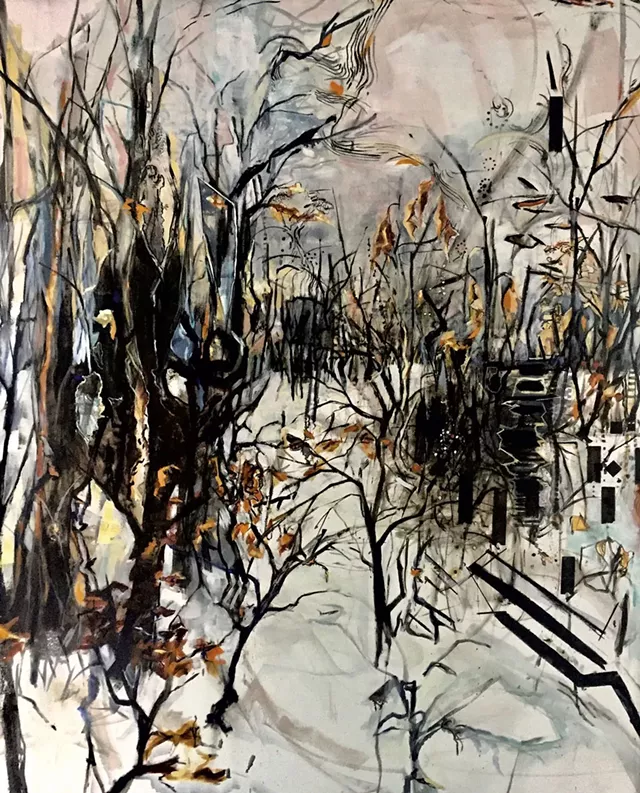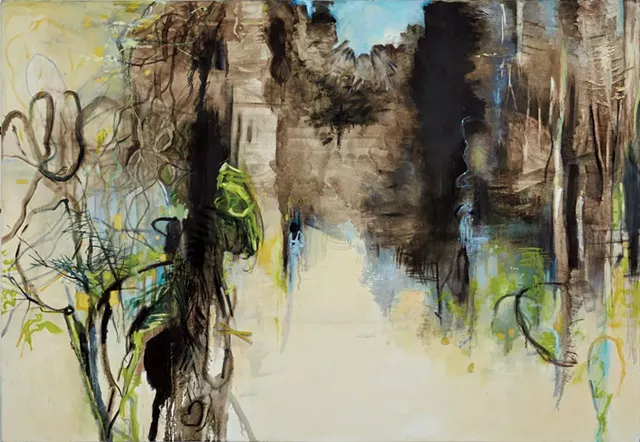It’s unusual for a Vermont gallery to host a solo show by Bunny Harvey, though the 78-year-old has spent summers in the Green Mountains since the age of 3 and works seven months each year at her house and studio in Tunbridge. More rare still is a Vermont premiere of new works by this experienced painter.
The BCA Center in Burlington proffers both treats with “Bunny Harvey: Worlds Within Worlds,” curated by director of exhibitions Heather Ferrell. The show brings together 22 recent works on canvas, paper and panel. Most were made between 2018 and 2025, though the smaller works, mostly abstract oils on 12-inch-square panels, date from 2009 on.
Harvey’s scant exhibition presence in Vermont over the years can be attributed to her success. The New York City-born artist won a coveted Rome Prize in 1976, one of few women up to that time to gain the honor. (Her husband, a writer, was given a studio of his own, though none of the male winners’ wives were given anything, she told Seven Days at her opening.)
For 30 years, Harvey was represented by Berry-Hill Galleries in New York City and by art dealer Terry Dintenfass, whose clients included major painters such as Jacob Lawrence. She worked in New York City and Providence, R.I., and still maintains studios in both places.
Now retired from 39 years of teaching painting at Wellesley College in Massachusetts and no longer desiring gallery representation, Harvey has been showing selectively at Vermont community hubs such as the Main Street Museum in White River Junction and the Tunbridge General Store. The nonprofit BCA’s show rewards with a broad look at a masterly painter.
The gallery commissioned two new works for this exhibition: “Singing Breathing Forest,” in oil on canvas; and “City with Blue Trees,” made on paper with pastel, charcoal and a vinyl paint called Flashe. BCA also funded a new iteration of “Walking with Water,” a video compilation of still photos of water. The video includes 157 images, whittled down from thousands, which Harvey shot on her iPhone while taking walks — a practice she started during the pandemic.
Harvey set the 17-minute video to composer Richard Reed Parry’s “Music for Heart and Breath,” an atmospheric piece for sextet on which her son, Nico Muhly, a lauded composer and pianist based in New York City, performs alongside New York’s yMusic ensemble. Harvey explained that the musical work requires each musician to wear a stethoscope and play to the tempo of his or her own heartbeat, a feature she thought “matched well with the pace of walking” that characterizes her project.
A fascination with the auditory runs in the family. Many of Harvey’s paintings at BCA are semiabstract landscapes, but their distant perspectives are balanced by foregrounded swirls and explosions of painted sound: the chitterings of birds and insects, the flitting of their wings, the buzz of a neighbor’s chain saw, the wind.
In the oil painting “Windborne Songs,” which some Vermonters may recognize from its inclusion in the 2023 Art at the Kent show in Calais, a viewer can almost hear the breeze shearing the water, represented in swaths of translucent white over a pond in hues of green darkened by the suggestion of rain on a distant mountain. A fury of upstrokes in blues and blacks in one corner of the 66-by-54-inch canvas calls to mind the cacophony produced by pond critters and birds.
Harvey’s paintings are not just about sight and sound but also the sensation of immersion in an environment — the latter enhanced by the compositions’ continuation onto the canvases’ 2-inch-deep edges. “A Solid Buzzing” is a 36-by-72-inch work in yellows, greens and periwinkle-tinged blue with a single thread of red. Black outlines define the elliptical paths of insects through the air, while changes in color and paint application on either side of those curves indicate the shifts in light and air wrought by those movements.
One tool Harvey employs to convey the ephemeral feeling of a change in the atmosphere is a notched trowel or scraper. She also uses “rags, brushes, splatters; I make cardboard curves and paint the edge and stamp it on,” she said. For “City with Blue Trees,” depicting an avenue seen from a few floors up through leafy trees, she covered her hands in Flashe and fingerpainted blue foliage — something she’d never tried before.
“If I could say what my paintings say with words, I wouldn’t paint. So, I find vocabulary in paint,” she explained.
Harvey doesn’t work from photographs. Instead, her paintings process what she absorbs and thinks about on her frequent walks, whether in Vermont or Rhode Island or between her room at 99th Street and her studio on 104th. “East Harlem Reverie” (oil on linen) and “Night Rose” (spray paint and oil on paper) each imagine the volunteer plants that grow from cracks in an environment otherwise contained by chain-link fencing and pavement.
“Walking in Reflections,” a 12-by-80-inch oil in grays, blacks, whites and faint greens, interrupts the long sweep of a landscape with inset rectangular frames and line breaks. The composition literalizes Harvey’s approach to painting, as she explained: “I think I make little framed windows or containers for the way I’m thinking about a particular place,” she said. “It could be a memory or an expectation of something that I will see along a walk.”
There is so much going on sensorially in the work, she added — “what I am smelling, trucks’ brakes I’m hearing, cows” — that rendering it in color would have been overwhelming, like “color hyperbole.”
Remarkably, Harvey’s synesthetic works, highly interiorized in their conception, open themselves to viewers’ own immersion. One’s eye and ear can get lost, for instance, in the thicket of small, abstract brushstrokes and shapes in unexpected colors of “Duet: Hidden Dwellings” while remaining anchored by its recognizable fields and distant farm buildings. Each journey into these “Worlds Within Worlds” is a pleasure.


